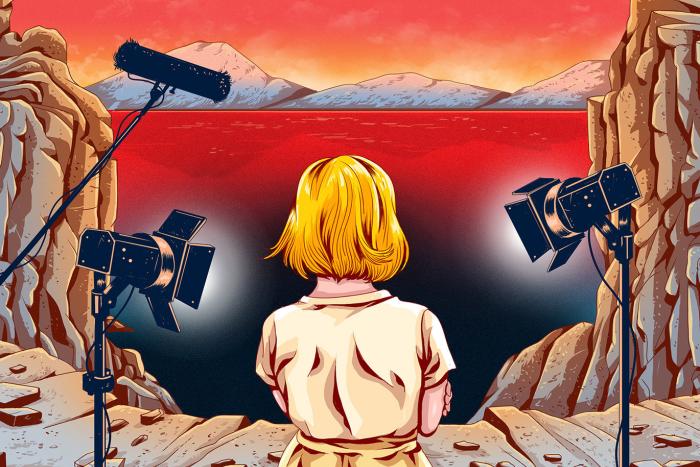The sky dances, but only for me. Lying on brittle sun burnt grass, I can stare up into that untouchable ocean and see it move. On the North Texas plains, where I grew up, nothing interrupts the sky; if I stand on a road that’s long enough, both horizons are visible just by looking right and left. That sky is giant, looming, and unbroken.
As a child, I thought I could see the air, could visualize the wind. Ribbons flipped over, and lines squiggled and bunched and drifted left and right in front of me. The air became permanent inside my eyes, my brain registering something real, something alive. I asked my sister, my parents, my friends to look at the sky with me, to see the strange movement that mesmerized me on days when the sun was high and the air thick with heat that radiated back up from the ground. But a glance is not enough to see the sky. It takes focus, and boredom, and the ability to let your eyes glaze over and see nothing but a shining, shaking, panel of blue.
I didn’t realize, when I drove a U-Haul packed with all of my belongings 1500 miles away from home to a new apartment and a new city on the East coast, that I was leaving the sky behind. All skies, I thought, were the same, until I moved and realized that can’t possibly be true.
*
In early photographs taken with long exposure times on clear days, the sky washes out, becomes a lightbox, stark, backlit. Looked at for long enough, it disappears. The sky is more void than substance, more air than material. It has almost no mass. The sky is not the crisp azul of morning. It is not the amber of sunset. It is never truly the blush of dawn. We say the sky is clear when it is vacant of clouds, but the sky itself is actually clear. Air molecules have no color, possess no character or influence. The sky exists only because we do.
The molecules of the sky, those tiny bumper cars of atoms, scatter the light of the sun, forcing it into smaller and smaller waves. Blue light has the shortest wavelength and so we see it the most clearly, our eyes performing a conversion of the world in front of us. We replace a mile of gas particles with a sea of cerulean. We build a perimeter for our world. We make the sky only for ourselves.
In every season, I know what the Texas sky looks like. Show me a photograph from the plains where I grew up and I can tell you the month. My brain reads the muted gray blue as January. The fluffy cotton candy clouds floating in a sea of Byzantine blue are May. A powder blue backdrop is October. Boyhood could only have been shot in the summer, probably July. No Country For Old Men must be May. Same for Dazed and Confused. The sky is more legible than a timestamp, more consistent than the follow of a shadow.
The sky, in theory, is universal. It connects us all, hangs over us all, is something we all share.
Except that my sky is special: my sky, the sky I crave and miss and dream about in my boring dreams.
The sky I grew up with is the same one that stretches from the Gulf of Mexico up into Canada. It is the sky of the Great Plains. These are flyover states to some, middle America to others, Big Sky Country to everyone who lives there, whether they know it or not.
In his 1834 travel journal-turned-guidebook, German settler Detlef Jordt described it as, “The clear, Italic sky, of which we can form no idea in our part of the world…” For visitors, the Texas plains inspire awe. “I am loving the plains more than ever it seems—and the SKY—Anita, you’ve never seen SKY—it is wonderful,” the painter Georgia O’Keeffe wrote to her friend in 1916 during her four year stint in the Texas Panhandle. “It is absurd the way I love this country.”
This obsession with the sky, the love of it, is embedded in the state’s pride. Like a long A in speech or cowboy boots, the sky deserves pride just for being there. The first two lines of the state’s favorite song, “Deep in the Heart of Texas,” are: “the stars at night are big and bright,” and “the prairie sky is wide and high.” Deeply ingrained in the state’s identity is access to this big, smooth, unchanging thing, this reminder that no matter how big our problems feel, or how bad the world gets, we are always small, always barely a blip under the dome of the heavens. “Like being close to the ocean,” Pulitzer prize winning author Lawrence Wright writes in his new book God Save Texas, “the sky [serves] as a natural point of focus for the contemplation of eternity.”
You grow up a soothsayer under that sky. On a clear day, when no clouds dare to interrupt the sweep of that cornflower backdrop, it’s almost as if you can see the future. Look at the horizon and any affront, any storm or shade, can be recognized and prepared for.
With these storms, the ones that come from the West, there is time: time to finish a game, or swim another lap in the pool, or go down the slide one last time before walking home. These are the storms with personality, that don't start with light rain, gentle sounds of approach, but with flashes of light, some snaking like varicose veins across the navy of approaching clouds, some bolting downward to earth. As a kid, we learned to count after the flash. One-Mississippi, Two-Mississippi, Three-Mississippi, Four-Mississippi, Five. If the boom came at five counts, the sound of the crash sometimes loud enough to make the earth feel like it shook, the storm was a mile away. Any closer, and it was already too late.
The weather is volatile that way, surprising. Its worst moods can produce hail the size of softballs and tornados that mow down entire homes in neat, seemingly calculated lines.
But that is a weather system. The sky only gives rainbows. It is stable. The sky does not change, does not move, does not ever disappear. Drive straight enough at 90 miles per hour through West Texas and it tracks you. Lie down on the ground in your front yard, and it might just dance. It makes sense there, that heaven is above us. Of course it must be. The ground dries out and kills things that grow. The sky never does. The sky is so blue and so rich and so unreachable that it must be a holy place, a home for no one but deities.
“I still feel sky-deprived when in the forested places. Many, many people born to the skies of the plains feel that way,” Larry McMurtry, author of Lonesome Dove, once wrote.
*
The first step of cultural adjustment, according to social psychologists, is euphoria. My first summer in Washington, D.C., I chugged euphoria. I saw the fireworks over the Washington monument and read in the grass. I found a new grocery store, and a new favorite restaurant. And then, the temperatures dropped overnight and it snowed before Thanksgiving and the cute pea coat I had worn in Texas became about as useful as a down feather bikini.
Even in this city of short buildings, the sky felt distant, a panel where a dome had been. Instead of feeling like a protector, it felt like a background. Even when clouds moved across it, it looked one-dimensional. It appeared briefly between buildings like a hole in the world, which was here on the ground, here in the deadlines and the errands and the freezing wind. Even when this city’s sky was blue, it felt restricted, limited. I stood on the two bridges near my house just to get a better glimpse, to try and see the curvature of the earth above me even though the world felt flatter than it ever had on the prairie.
Winter came quickly and I floundered. A tidal wave of clinical depression tried to drown me, and I entered the second phase of adjustment: “culture shock.” The grocery store didn’t sell any real salsa, I realized. Days disappeared more quickly than I knew they could, the sun rising after I walked through the hazy morning light to the office and gone before I headed home. Maybe time moves slowly on the plains because you can see it, see the sun emerge from the other side of the world and drift lazily up and across and back down again: every moment of it visible from any part of the tortilla-flat land. Here on the coast, the gray winter clouds sat on top of the short buildings like a lead blanket. And the sky was gone.
The muscles in my neck started to shorten when I moved. All day, I looked down: down at my phone; down at the sidewalk threatening to trip me; down at my hands while they flew over the keyboard anxiously; down at my dog while we walked. I could feel them shortening, before I knew that was what it was, could feel a tightness around my vocal cords that disappeared if I lifted my head a little to look straight, that pulled when I stretched my head upwards.
I never realized what that blueness, a clear sky, seeing the sun does to my mood until I went home for Christmas that first winter. The sky greeted me, open and giant. “It is strange to see the plains again with nothing to break the view in any direction as far as we can see,” Laura Ingalls Wilder wrote to her husband in 1919. She had forgotten, during her years living in the Ozark Mountains, what it was like to disappear “under the sunset and starlight of the prairie.”
Returning to that sky was like chopping off six inches of hair. I felt lighter, leaner, expectant. “Room to make a big mistake,” the Dixie Chicks called the land with that kind of sky, maybe because there’s less risk there, fewer people watching. Promise is all above you, in the sky, far away, glimmering, easy to understand.
What is the opposite of claustrophobia? Of needing something so big and so much that it hurts to be returned to it? Is that just homesickness?






